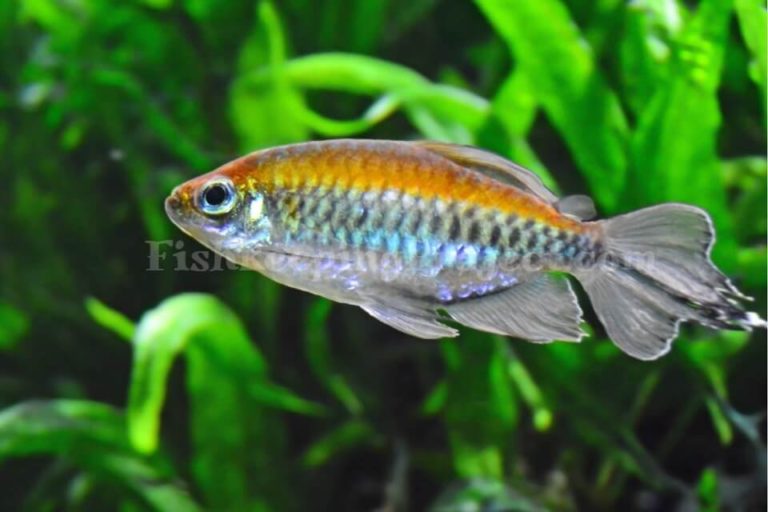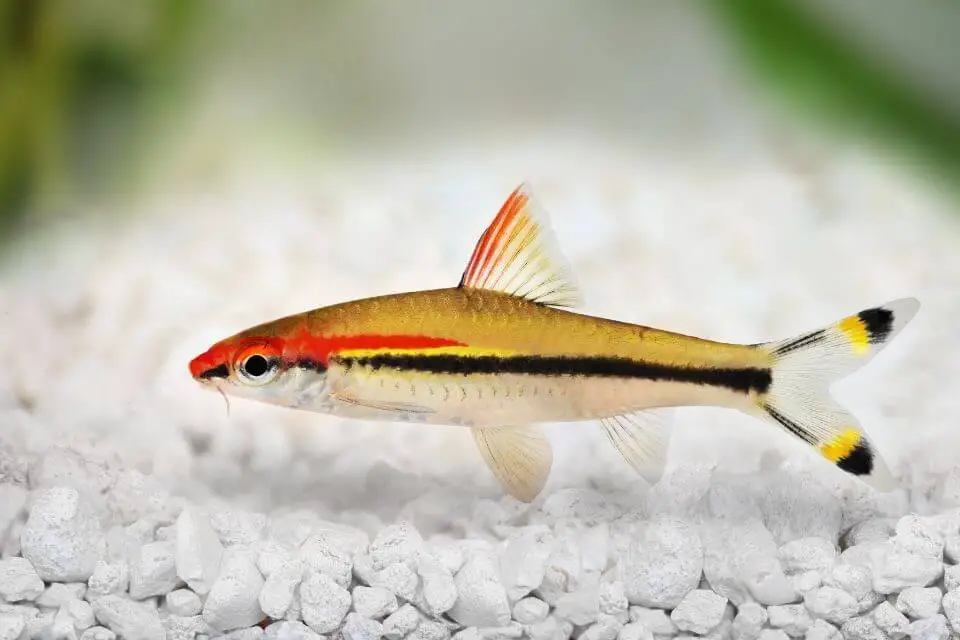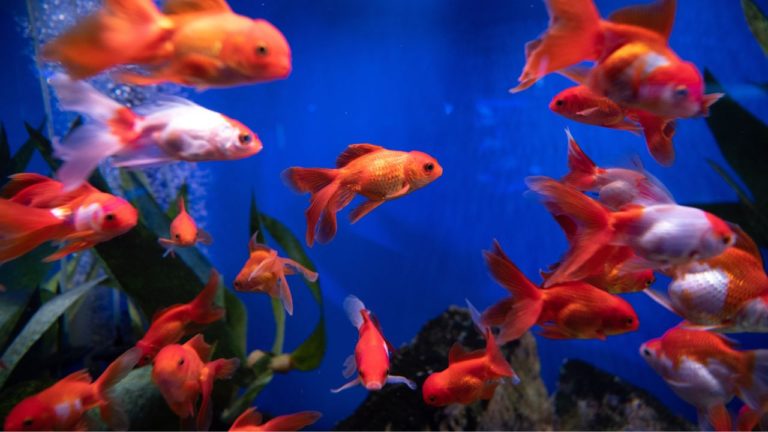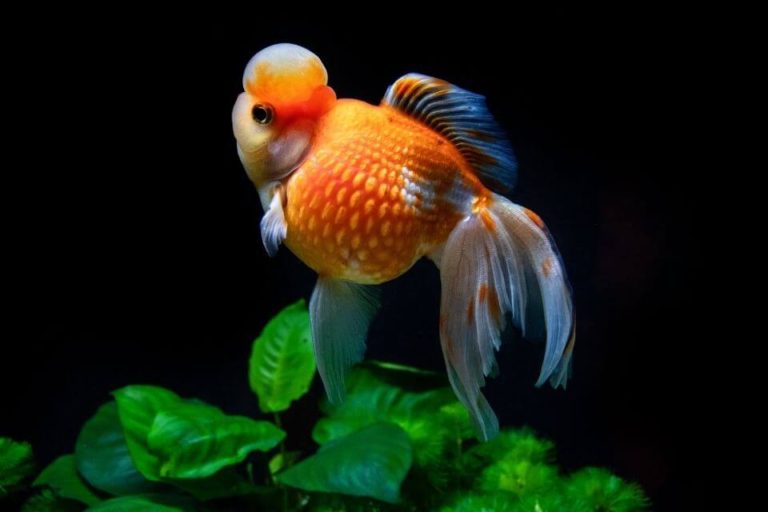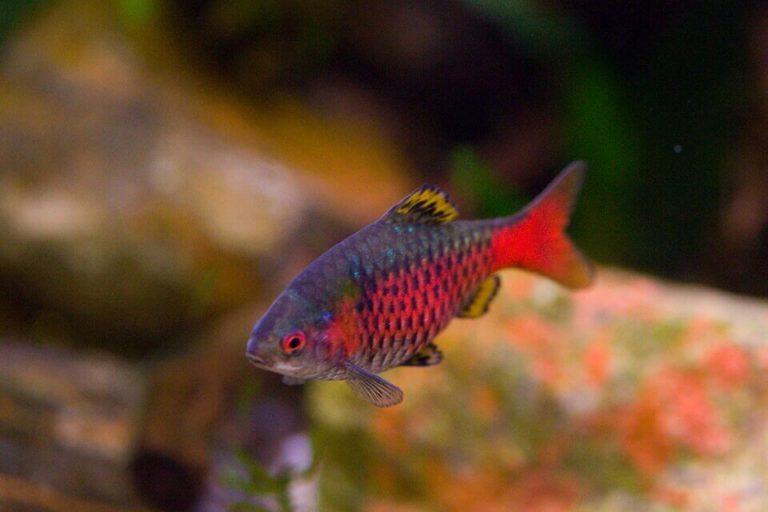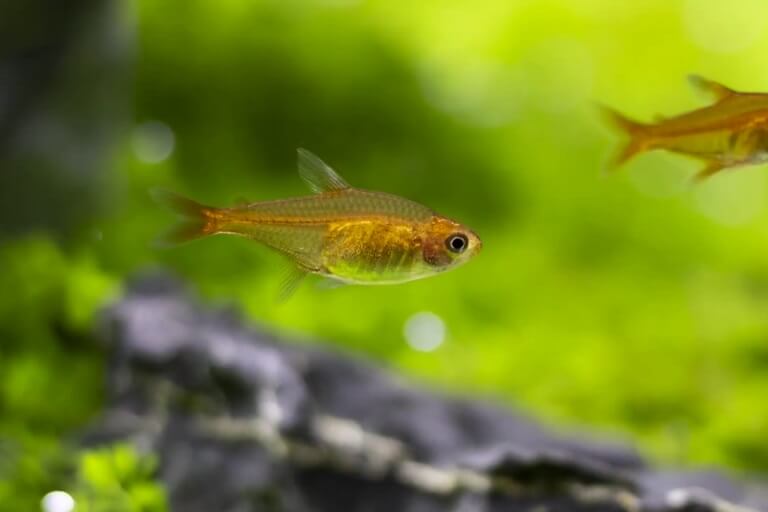Powder Blue Gourami Care Guide: Tank Mates, Tank Setup and Diet
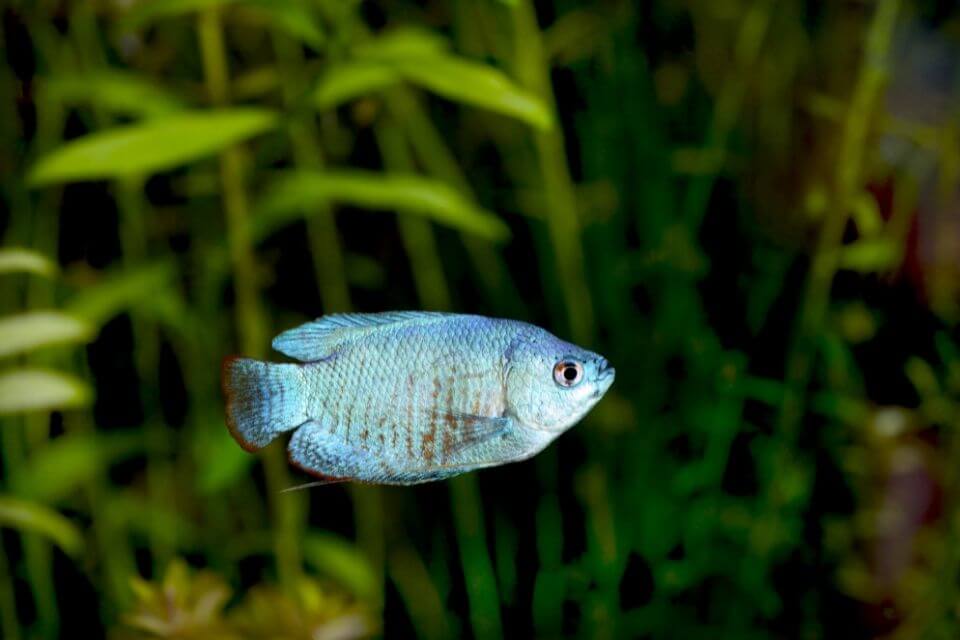
Are you fish keeping enthusiastic who are willing to keep colorful fish species in your freshwater aquarium? There is no other choice like Powder Blue Gourami that beautify your living rooms and other interior spaces.
Keep reading to know how to care for, keeping and breeding of this wonderful aquatic species.
Species overview
In a nutshell, the Powder Blue Dwarf Gourami is a freshwater fish species that you can keep with many peaceful tank mates.
It is iridescent in the sense that it seems to exude different colors depending on the angle you view it from. Some of the colors it assumes are the red vertical stripes and the powder blue.
Unlike other fish species, this is a labyrinth. This means it breathes direct from the air as opposed to using its gills to sieve out the air from the water. For this reason, the fish species has to get to the surface of the water every quite often and cannot sink deeper below the same surface.
On the whole, this species is hardy and tolerant of a couple of sicknesses and complications. At the same time, it is a lot easier for a beginner level to an expert fishkeeper to take care of this fish species.
This stems from the fact that it does not demand too much care and attention as it is the norm with many similar species.
Typical Behavior and Temperament
This fish species, as has already been stated, likes floating next to the surface of the water. Their gills are incapable of drawing oxygen that is dissolved in the water. It is only by getting close to the surface that they may be able to breathe.
Stemming from this, the fish species tend to spend much of their time in the upper to the middle columns of the water tanks. Hardly does it sink to the bottom, or even if it does, it will only stay there for a very short duration of time.
They are generally aggressive in their hunt for food and combating the likely predators. Because of this, some degree of caution is called for when handling and interacting with this fish. You do not want to cross its paths lest you get in harm’s way.
You will see the species chase after other fish in the aquarium while also nipping at their fins during the spawning period. In the absence of prey or other fish, this species is generally relaxed and less active.
When first introduced into the aquarium, they are shy and tend to hide from the view of others.
Origin and Distribution
This fish species originated from Asia. In that continent, it is found in the slow-moving waters that have dense vegetation. These include lakes, marshes, canals, streams, ponds, and shallow ocean fronts.
Most commonly, the species is found in large numbers in Bangladesh, India, Vietnam, Thailand, Malaysia, and Pakistan. Outside these regions, the fish is restricted to lakes, streams, rivulets, wetlands, and temporary pools. These include regions like Japan, Korea, and China.
Other than the aforementioned, the species is also reared in many aquariums within households around the world. It is this purpose in fact that forms the basis of our discussions in this article.
Powder Blue Gourami Size
This fish species has male and female variants, as is any other species. The exact size of the fish largely depends on the sex of the fish thereof. We now break down the fish variety to explain the size in line with the sex thereof.
– Male Powder Blue Gourami Size
This grows to a maximum size of about 3 inches (roughly 7.5 cm). For this size to be attained, the male has to be fed a balanced diet that contains higher levels of nutrients. Then again, it has to keep in optimal environments for it to thrive luxuriously.
– Female Powder Blue Gourami Size
The female counterpart has a slightly smaller size that comes to about 2 1/3 inches (6 cm). Though smaller than its male counterpart, the female has to be fed well and placed in a great environment for it to attain this maximum height.
The diet has to contain higher levels of proteins.
Powder Blue Gourami Lifespan
Regardless of the gender of the fish species, they do have an average lifespan of about 4 years but can nonetheless attain the 7 years threshold. Yet again for this threshold to be attained, the fish has to care for well and treated for every disease they might have.
Appearance and Colors
We started by stating that this fish species is iridescent. This simply means that it can ‘change’ its color. That is to mean, that how it appears, is largely dependent on the angle from which you view it.

Some of the leading colors it assumes are the vertical stripes and the powder blue. Its male variant has a long and slightly pointed dorsal fin.
It also displays a red body color at the time it is finally ready to reproduce. Its female variant on the other hand has a short and rounded dorsal fin. Unlike the male counterpart, this one maintains its basic color throughout.
Outside their basic colors, the male and the female also exhibit other appearances. The males, more so those in the wild, do have diagonal stripes that alternate the red and the blue colors. Their females do display the silvery colors besides.
But under what circumstances does the species alter its colors? In most cases, the change of color is largely determined by four main factors.
These are the prevailing moods, the angle from which you view the fish, the external environmental conditions/circumstances, and the reproduction/spawning cycles.
Powder Blue Gourami Care
While at the aquarium, these fish species require some tender care and exceptional oversight. To guarantee proper growth, the aquarium has to be heavily populated with plants. Its surface must also comprise the floating plants to act as ready food for the fish when they get there to breathe.
– Powder Blue Gourami Tank Size
The recommended tank size is 10 gallons or bigger. This is to give the fish species sufficient room to float around and thrive luxuriously. Also, it prevents the species from developing any aggression towards other members of the same tank who might confront it in whichever shape or form.
– Water Parameters
Other than the sheer massive volume, the water in the tank should have a pH of about 6.8 and 7.8 and an alkalinity of about 3 to 8 dKH (50 ppm to 140 ppm). The water temperature on the other hand should be between 75° and 80° F. Lastly, the hardness has to be around 2 and 18 degrees.
– Suitable Plants
Apart from the Gourami itself, there are several aquarium plants that you can include at the time you set up the take to ensure the proper growth of the fish species. These plants ought to be taller, bushier, and floating.
They include:
- Amazon Frogbit
- Duckweed
- Dwarf Water Lettuce
- Hornwort
- Anubias
- Amazon Sword
- Water Wisteria
Common Possible Diseases
Like any other species, these too, are commonly affected by sicknesses of all kinds. In this segment, we point out a couple of the common diseases that potentially bedevil them and offer more explanations thereafter.
– White Slime
The white slime affects the scales. This is often brought about by the uncontrolled release of white mucus. At this point, the fish is generally restless and nervous even when not provoked by an external agent. You have to change the water and substitute the same with fresh ones.
– Red Spots
This menace arises mainly during the spawning period. It mainly arises from internal abnormalities or as a result of the open exterior wounds due to physical injuries. Administer antibiotics to the open wounds to reverse the issue. Find out the root causes and deal with the same to avoid a recurrence of the problem.
– Peel-off Of The Scales
Apart from whitening, the scales may also peel off on their own. This could be due to many reasons like physical abrasion from sharp objects, fungal and bacterial infections, osmotic stress, and old age. Whereas the menace is to some extent inescapable, it is something you want to bring a vet to address.
– Reddish Fins
The fins of the Gourami have to assume the same colors as the rest of the body. In some instances, the fins could also turn red. This is mainly due to the disturbances in the balance of Nitrogen in the aquarium or even chemical poisoning. Bring in a vet to administer the correct treatments.
– Swollen Belly
Of course, this is caused by bloating and is largely accompanied by minimized fish activities and reduced appetites. Mostly, it is the worms that are largely responsible for this menace.
Tapeworms are particularly notorious for the emergence of this issue. You are asked to administer deworming agents to counter the problem.
– Darker and Blackened Exterior
Once in a while, the exterior of the fish may darken. This is largely brought about by changes in the exterior water environment. These could come in the forms of the food rations, the composition of water, and exterior chemical components. All you have to do is change the water and that is it!
Powder Blue Gourami Diet and Feeding
This fish species is omnivores in the sense that it feeds on both plant and animal food sources at the same time. For plants, it feeds on the algae-based feeds while for the animals, it prefers meaty meals.
Other than the natural foods explained already, the species also prefers some processed varieties.
Examples of these are brine shrimp, tubifex, and freeze-dried bloodworms. As a general rule, you should administer small amounts of food twice daily.
This is to give the fish ample time to digest the feeds and assimilate them into their systems. That in turn ensures proper growth and development.
Powder Blue Dwarf Gourami Tank Mates
On the whole, the fish species work alongside the bottom-dwellers aquatic species. That is for the sheer reason that they stay in the upper segments of the typical water bodies. As such, the bottom dwellers give them the room to thrive freely and prevent any forms of unnecessary collisions.
Common examples of these are:
- Angelfish: It is a freshwater fish species that are endemic to South America but nonetheless does well in most indoor aquaria. The species does not compete with the Powder Blue Gourami and is hence a suitable mate.
- Rasboras: They are peaceful and very colorful. Because of this, the species is likely to complement the aesthetics that the Powder Blue Gourami brings about. That it does not compete in terms of food makes it a plus.
- Corydoras: These typically occupy the bottom segments of the tanks. That makes them leave sufficient rooms for the Powder Blue Gourami at the top. Due to this arrangement, there are hardly any collisions between the two.
- Neon Tetra: Are well known to be active yet peaceful at the same time. Moreover, they blend well with the other members of the aquarium to allow for peaceful co-existence.
- Cardinal Tetra: Smaller and hence takes up fewer storage spaces. Given the calm nature of this species, it hardly interferes with the activities of the other fish species that exist in the tank.
- Mollies: Mollies are also smaller and less likely to impede the activities of the other fish in the aquarium. That they occupy the bottom segments of the water tanks makes them good enough for the Gouramis.
- Zebra Danios: Stand out from many of the leading aquatic animals in the sense of being easier to care for. Thanks to their hardy nature, they are also less prone to fall sick and transmit sicknesses to the Powder Blue Gourami.
- Otocinclus Catfish: This fish that belongs to the catfish family is dwarf and hence smaller in stature. Additionally, it is also herbivores and will less likely threaten the growth of the Powder Gouramis.
Gender Differences
The male and the female sexes of this wonderful fish species have marked differences. We now identify and explain these differences against the leading parameters.
– Physical Size
When all factors are put into consideration, the males of the Powder Blue Gouramis are larger in size than their female counterparts.
They grow to a length of around 3 inches while their females manage a paltry 2 ½ inches. This difference is largely anchored on the genetic makeup of the fish altogether.
– External Colors
The males have a distinctive silver color that sparkles when beheld with the eyes. As for the females, their color varies to reddish. Nonetheless, they both have a unique Powder Blue external appearance.
It is this appearance in fact that makes the fish stand out from the other species.
– General Behaviors
Both sexes are calm and peaceful. However, the males tend to be aggressive when they come across a new foreign species. The females on the other hand only get wild during their spawning periods.
You hence have to take great care that you do not introduce anything that may agitate the fish.
Powder Blue Gourami Breeding
When this species is finally ready to breed, you will observe that it displays some rather strange behaviors. Its male will usually start dancing with the female. The female on the other hand will often start to cup her body with the males.
Then, it wiggles while getting closer after which it lays the eggs.
At this stage, the male will now fertilize the eggs that are laid by the females. Fertilization occurs outside rather than in the body of the female.
For better breeding, you are asked to furnish a breeding tank that measures 10-20 gallons and maintain the water levels to about 6-18 inches (15 – 20 cm).
Are Powder Blue Gourami Hardy?
YES, they are! This species is less inclined to the infestations of the diseases. That means it hardly falls sick and hence spares you from the otherwise hefty costs of treatments. Nonetheless, you also have to see to it that you maintain its breeding tank in perfect hygiene.
That is because areas with poor hygiene are prone to all kinds of sicknesses and disease agents like tapeworms, bacteria, fungus, and other aquatic damages. There are things you ought to do to prevent the diseases from arising.
Changing the water every now and then, administering deworming agents, and bringing in a vet to inspect the tanks are some of the strategies that may help you out. Prevention is of course better than cure. Do not wait for issues to get out of hand before acting.
Are Powder Blue Gourami Aggressive?
NOT REALLY! This fish species is generally very peaceful. For this reason, it gets easily intimidated by the large, active, and aggressive fish varieties.
What does that imply? You have to take appropriate measures to keep the fish species away from the active and aggressive ones.
When introduced into the aquarium for the first time, the species tends to be shy and timid. They take a while to be fully acquainted with their new environments. Though peaceful, you should never place two males of this fish species in the same tank. Chances of them fighting are generally higher.
How Many Powder Blue Dwarf Gouramis Can I Keep Together?
2 or 3 may be kept in a tank whose capacity is 10 gallons. If you have to introduce more fish in the same tank, you have to increase the capacity appropriately. Generally, add 5 gallons for every additional fish you bring on.
Then, try as much as possible never to place two males in the same tank at the same time.
Do Gouramis Like To Be In Pairs?
YES, on the condition that they are not members of the same gender. The males of this species do not like to be paired up in the same container at the same time. If you have to bundle them in pairs, make a deliberate effort to only place two members of different sexes in the tank at the same time.
Also, this species is naturally solitary. It does not like operating as a group as the other counterparts ordinarily do. Make the tank really big if you want to add many of them at the same time. That will give each fish the room to roam around freely.
How Big Do Blue Gouramis Get?
Five inches, it is! The males are bigger than the females. Their average length is about 6 inches while that of the females is about 4-5 inches.
Where Female Powder Blue Gourami for Sale?
You may find the female Powder Blue Gourami for sale in many areas. These could include breeding centers and other large-scale aquaria. We urge you to get online as that is the place where you may get the best deals possible.
If you have the means, you may also source directly from the countries where the fish species is endemic like Bangladesh, India, and Pakistan.
Final Thoughts
We now close our long and in-depth peek into the Powder Blue Gourami. It is now our firm confidence that you have what it takes to appreciate the species better and even make a suitable purchase of one.
With that insight in mind, we now challenge you to move a step further and implement the provisions.
Of course, that cannot mean anything else save for you now making arrangements to acquire and incorporate the fish species in your indoor aquarium. How soon do you plan to do so? Kindly inform us in the comments section below.
We cherish the responses of the readers of our posts.



